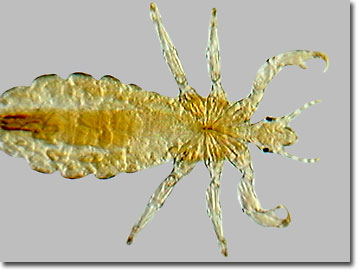Oblique Digital Image Gallery
Human Head Louse
Feeling lousy may mean more than having a bad day, particularly if one's head is itchy. Infestations by the human head louse plague many school districts across America and around the world. Head lice, known scientifically as Pediculus capitis, are blood-sucking members of the Class Insecta, and as small parasites, are exquisitely fit to live on the scalp and neck hairs of human hosts.

View a medium magnification image of the human head louse.
View a high magnification image of the human head louse.
Demonstrating a near-perfect illustration of coevolution, the six legs of the head louse are adapted for efficiently grasping the person's hair shafts. Head lice infest new hosts mainly by direct head-to-head contact with infected hair, but may be transferred by contaminated combs, hats, or other hair and head accessories. For a brief period of time, human head lice can survive living freely on upholstered furniture and bedding. Children are more frequently infested than adults and louse infestations seem to have little to do with personal hygiene, sanitation practices, or socioeconomic classes.
At least once a day, the parasitic insect must feast on a blood meal or else die. After eight days of development, a nymphal louse hatches from its egg or nit, beginning the life cycle of feeding, growing, and maturing until at age 9 to 12 days, the adult stage is reached. Each female louse may deposit in excess of 100 eggs at the rate of approximately six per day. Although the average host's head may house only a dozen or so active lice at any given time, there may be hundreds of nits visible on the scalp under magnification. Closely related body lice, as their name implies, are found on the human body everywhere except the scalp and facial hair. Although head lice are more of an annoyance than a threat, associated ill advised "cures" using caustic or toxic substances to eliminate the lice may actually create the greatest harm. In some cases, no treatment is recommended, particularly if the nits detected are nonviable.
Contributing Authors
Cynthia D. Kelly, Thomas J. Fellers and Michael W. Davidson - National High Magnetic Field Laboratory, 1800 East Paul Dirac Dr., The Florida State University, Tallahassee, Florida, 32310.
BACK TO THE OBLIQUE IMAGE GALLERY
BACK TO THE DIGITAL IMAGE GALLERIES
Questions or comments? Send us an email.
© 1995-2025 by Michael W. Davidson and The Florida State University. All Rights Reserved. No images, graphics, software, scripts, or applets may be reproduced or used in any manner without permission from the copyright holders. Use of this website means you agree to all of the Legal Terms and Conditions set forth by the owners.
This website is maintained by our
Graphics & Web Programming Team
in collaboration with Optical Microscopy at the
National High Magnetic Field Laboratory.
Last Modification Friday, Nov 13, 2015 at 01:19 PM
Access Count Since September 17, 2002: 13436
Visit the website of our partner in introductory microscopy education:
|
|
